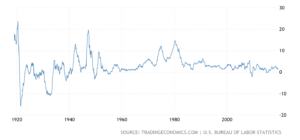Part one of a two-part series on the Fed’s approach to inflation. Part two will appear next week.
There’s probably not a consumer in America who worries about prices being too low.
Yet low inflation scares members of the Federal Reserve Board. Then again, they’re professional economists. What do they know?
Not much, based on recent history.
The Fed has been trying for seven years to push inflation up to 2% and has mostly failed. We wrote in November 2018 that the 2% rate had been reached, and, in fact, inflation was above 2% for the entire year. But this year it’s been below 2% except for April, and it has recently been trending between 1.6% and 1.8%.
Woe is me, if you’re a Fed member.
Fear of Deflation
The Fed and other economists fear deflation, which is what happens when prices go down instead of up. Lower prices have historically been a sign that manufacturers were losing confidence in their products. And if consumers know that prices are going to be lower tomorrow than they are today, they may wait until tomorrow to make a purchase.
As a result, profits could tank and the economy could plunge into a recession. Never mind that the economy has been booming in spite of low inflation in recent years.
So, even though a rate of 1.6% is much closer to the Fed’s arbitrary 2% target than it is to deflation, the Fed is concerned that inflation isn’t high enough.
What Drives Prices
Today, though, prices are often driven by technological developments. Large screen TVs, computers, smartphones and other products have become much cheaper. Fracking has kept energy prices in check, while making the U.S. the world’s largest producer of oil. Technology has made automobiles more reliable, so we’re spending less on repairs. It has enabled industries to produce goods at a lower cost by increasing efficiency.
Global competition has also kept prices low. China and other emerging markets with lower labor costs than the U.S. have been able to produce goods and import them to the U.S. at a lower price. Likewise, U.S. companies need to keep their prices low to remain competitive.
And while many factors are driving prices lower, it may seem as though the rate of inflation is higher. Gas is still approaching $3 a gallon in spite of fracking and food seems increasingly unaffordable – but food and energy are not included in core inflation calculations, because their prices are too volatile.
Even if the Fed were able to increase inflation, it would likely overshoot its target and high inflation would stunt spending, slowing economic growth.
We’ve suggested previously that if the Fed is going to have a target for inflation, it should be 0%, which is what Congress mandated when it passed the Full Employment Act in 1978. That goal was never achieved, but inflation dropped to an acceptable level after rising to double digits in the mid-’70s and again from 1979 through 1981, even as the economy stagnated.

